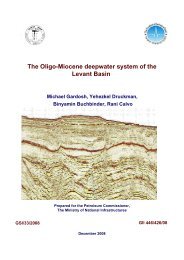The Geology of the Elat Sheet Explanatory Notes
The Geology of the Elat Sheet Explanatory Notes
The Geology of the Elat Sheet Explanatory Notes
You also want an ePaper? Increase the reach of your titles
YUMPU automatically turns print PDFs into web optimized ePapers that Google loves.
and <strong>Elat</strong> Granite, 630 Ma (Beeri-Shlevin et al., 2009) in <strong>the</strong> <strong>Elat</strong> and Roded blocks mark<br />
<strong>the</strong> cratonization, post-collision phase <strong>of</strong> <strong>the</strong> orogen. Some foliation was observed in <strong>the</strong><br />
Shahmon Metabasite, Roded quartz Diorite and in <strong>the</strong> <strong>Elat</strong> Granite. Eyal et al., (2004)<br />
suggested that <strong>the</strong> <strong>Elat</strong> Granite is composed <strong>of</strong> two plutons; <strong>the</strong> one on <strong>the</strong> eastern<br />
margins <strong>of</strong> Mt. Shahmon is metamorphic and is <strong>the</strong>refore distinguished by <strong>the</strong>m as <strong>the</strong><br />
Shahmon Granitic Gneiss.<br />
<strong>The</strong> intrusions <strong>of</strong> <strong>the</strong> alkaline granites such as <strong>the</strong> Amram, Shahmon and Yehoshafat<br />
granites, 608 Ma ( Be'eri-Shelvin et al., 2009; Morag et al., 2011), is accompanied by<br />
rhyolite dykes, 609 Ma (Morag and Avigad, 2010), andesite and composite dykes which<br />
mark <strong>the</strong> extension phase (Beyth et al., 1994). In places such as <strong>the</strong> "Dyke Country" at<br />
Mt. Shelomo <strong>the</strong> dykes form 85% <strong>of</strong> <strong>the</strong> outcrop (Gutkin and Eyal, 1998). <strong>The</strong> Shahmon<br />
Granite intrudes <strong>the</strong> Quartz Diorite Roded in numerous small intrusions (Bentor, 1961).<br />
3.1.3 <strong>The</strong> volcano-conglomeratic event is <strong>the</strong> final major magmatic event in <strong>the</strong> <strong>Elat</strong><br />
area, represented by <strong>the</strong> Amram Rhyolites, basalts, andesits and conglomerates <strong>of</strong> <strong>the</strong><br />
Mapalim Formation in <strong>the</strong> Roded block (Paz, 1997), andesites and trachytes at Gevaot<br />
Shehoret (Peltz and Eyal, 1995), acid volcanic rocks at <strong>the</strong> Yotam Caldera (Eyal and<br />
Peltz, 1994), <strong>the</strong> basalt and andesite volcanic rocks in Mt. Shelomo in <strong>the</strong> <strong>Elat</strong> block,<br />
hypabyssal shallow intrusions <strong>of</strong> <strong>the</strong> Amram Monzonite and Amram Quartz Syenite<br />
(Mushkinet al., 2003).<br />
<strong>The</strong> Roded Conglomerate, <strong>the</strong> Mapalim Formation and <strong>the</strong> <strong>Elat</strong> Conglomerate in Mt.<br />
Shelomo (Gutkin and Eyal, 1998), dated at about 590 Ma (Morag et al., 2011), are <strong>the</strong><br />
products <strong>of</strong> a major erosion phase in which 12,000 m <strong>of</strong> <strong>the</strong> section were removed<br />
(Garfunkel, 1999). <strong>The</strong> <strong>Elat</strong> Conglomerate is a product <strong>of</strong> cohesive debris flows while <strong>the</strong><br />
Roded Conglomerate and <strong>the</strong> Mapalim Formation are fluviatile sediments (Kagan et al.,<br />
2010). Rhyolite, andesite and composite dykes 585 Ma.<strong>of</strong> age (Katzir et al., 2007)<br />
intrude <strong>the</strong>se conglomerates. A petrologic study <strong>of</strong> <strong>the</strong>se dykes intruding <strong>the</strong> <strong>Elat</strong> Granit<br />
at Mt. Shahmon was done by Kessel et al. (1998). <strong>The</strong> youngest dyke, 532 Ma <strong>of</strong> age<br />
(Beyth and Heimann, 1999) below <strong>the</strong> peneplain is <strong>the</strong> dolerite dyke which was mapped<br />
in <strong>the</strong> <strong>Elat</strong> <strong>Sheet</strong> at <strong>the</strong> sou<strong>the</strong>rn part <strong>of</strong> Mt. Amram. Identical ages were reported from<br />
<strong>the</strong> dolerite intrusions in <strong>the</strong> Zenifim Formation (Weissbrod, 2005). <strong>The</strong> Early Cambrian<br />
peneplain was formed by erosion <strong>of</strong> 2,000 m <strong>of</strong> <strong>the</strong> section (Garfunkel, 1999) and<br />
chemical wea<strong>the</strong>ring. At <strong>the</strong> junction <strong>of</strong> Nahal Amir and Nahal Shehoret <strong>the</strong> Roded<br />
Granite Porphyry was altered to kaolinite, suggested by Sandler et al., (2010) to be a<br />
relict <strong>of</strong> a thick lateritic section which was removed before <strong>the</strong> sedimentation <strong>of</strong> <strong>the</strong><br />
conglomerates <strong>of</strong> <strong>the</strong> Amudei Shelomo Formation.<br />
As a result <strong>of</strong> <strong>the</strong> geochronological studies two possible major breaks in <strong>the</strong><br />
Neoproterozoic magmatic activity are suggested: ~60 million years break between <strong>the</strong><br />
metamorphic rocks and <strong>the</strong> calc alkaline intrusions and ~55 million years between <strong>the</strong><br />
rhyolite, andesite and composite dykes and <strong>the</strong> dolerite dyke.<br />
3.2 <strong>The</strong> sedimentary rocks (Fig. 4). <strong>The</strong> pre-Dead Sea Transform sediments, from<br />
Cambrian to Eocene, consist in <strong>the</strong> <strong>Elat</strong> area <strong>of</strong> five groups: Yam Suf, Kurnub, Judea,<br />
Mount Scopus and Avdat.<br />
3.2.1 Yam Suf Group: <strong>The</strong> lower, Cambrian part <strong>of</strong> <strong>the</strong> sedimentary section comprises<br />
four formations: Amudei Shelomo, Timna, Shehoret and Netafim, which were described<br />
by Weissbrod (1969, 2005) and Segev (1986). <strong>The</strong>y onlap <strong>the</strong> Early Cambrian peneplain<br />
3

















